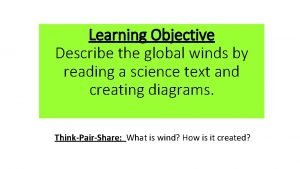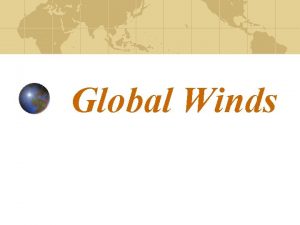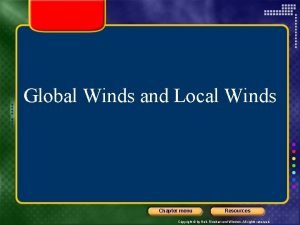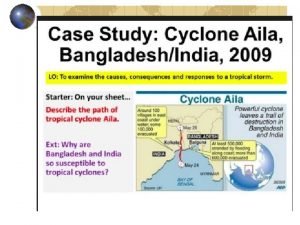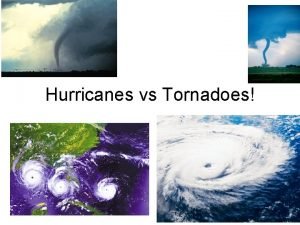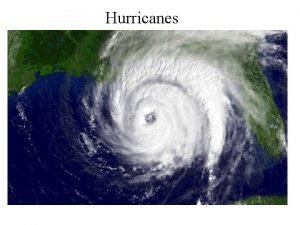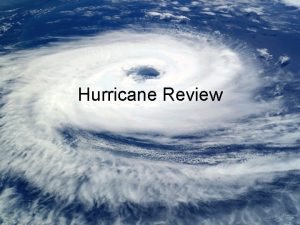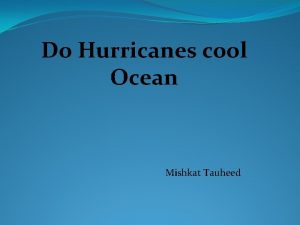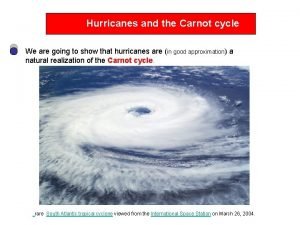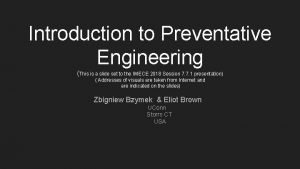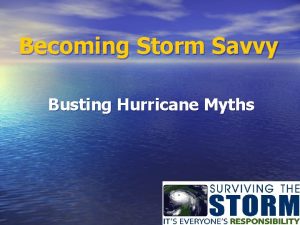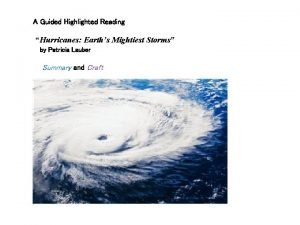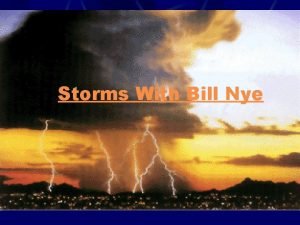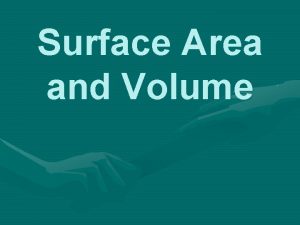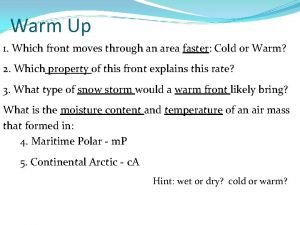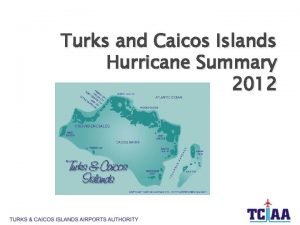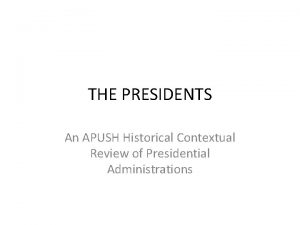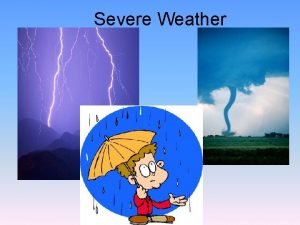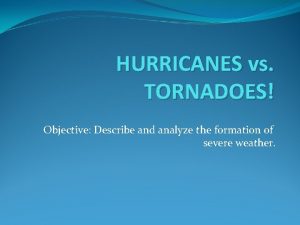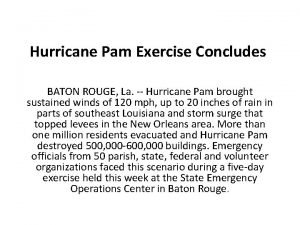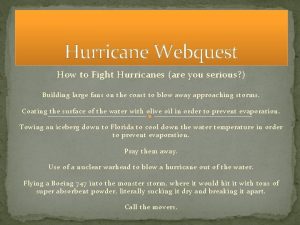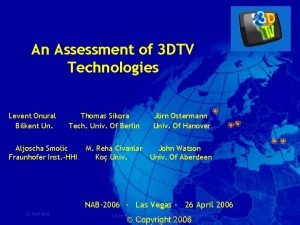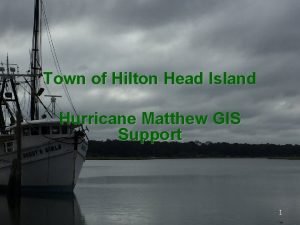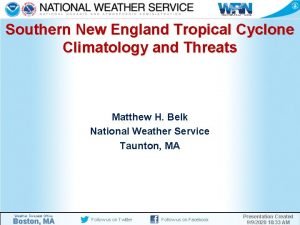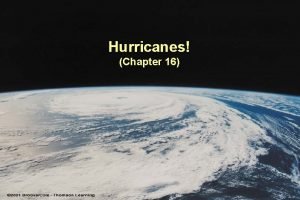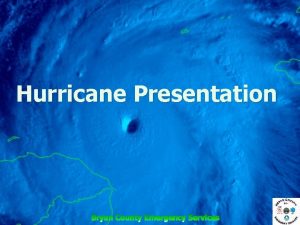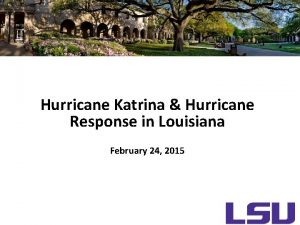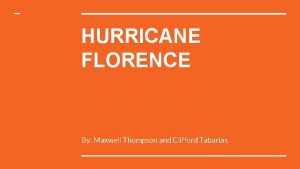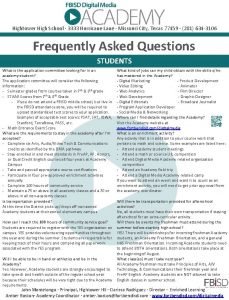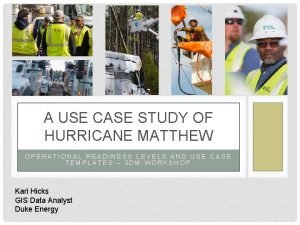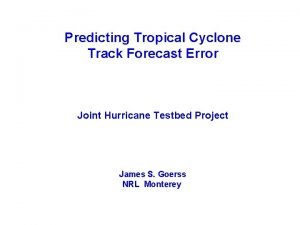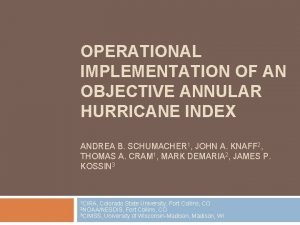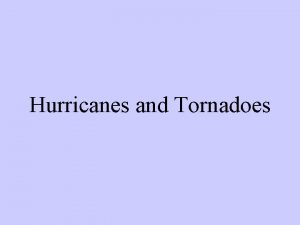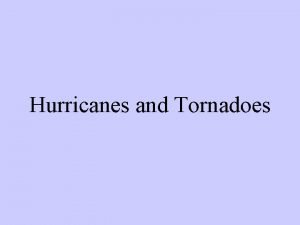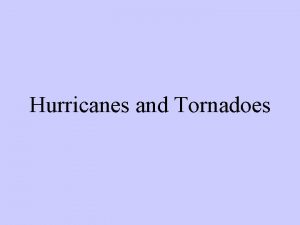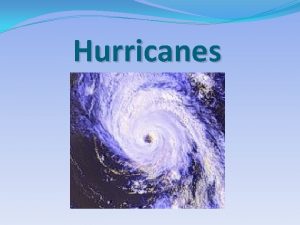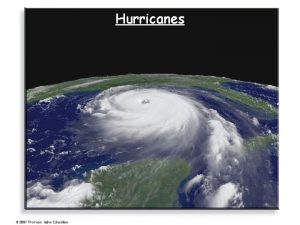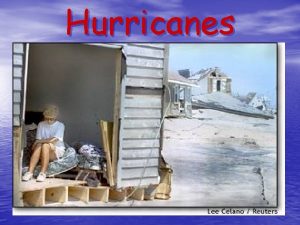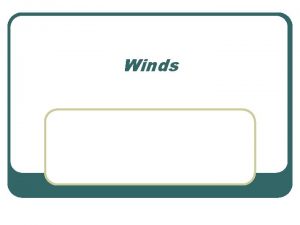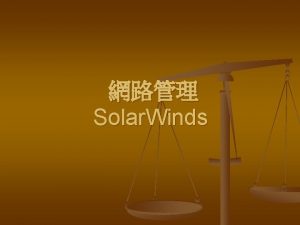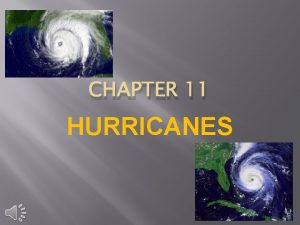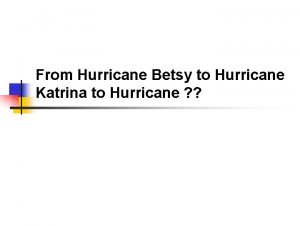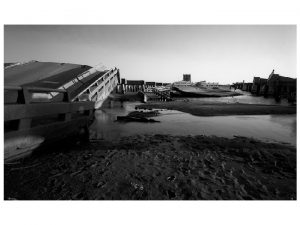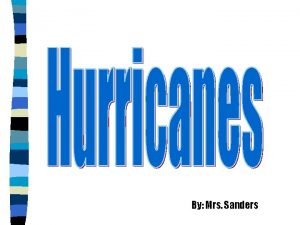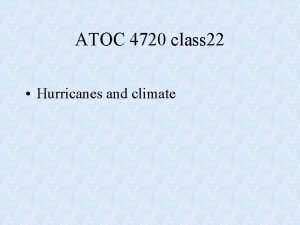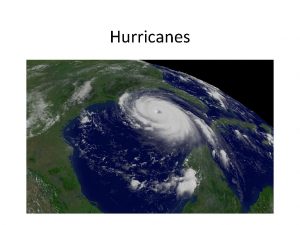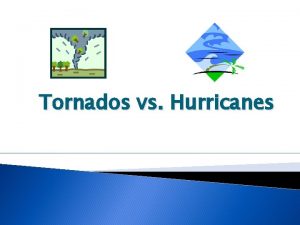Hurricane Review Surface winds in hurricanes typically reach













































- Slides: 45

Hurricane Review

Surface winds in hurricanes typically reach a maximum in the • a. Eye • b. Eyewall • c. anvils

1. Streamlines on a weather map depict: • • • a. water temperature b. pressure c. wind flow d. dew point e. ocean currents

2. Which of the following is not true concerning an easterly wave? • a. moves from east to west • b. has converging winds on its western side • c. showers and thunderstorms may be found on its eastern side • d. indicates a region of lower-thanaverage pressure

3. Pressure at the center of a hurricane is ____ than the surroundings at the surface and ____ than the surroundings aloft. • • a. higher, lower b. lower, higher c. lower, lower d. higher, higher

4. The vertical structure of the hurricane shows an upper-level ____ of air, and a surface ____ of air. • a. outflow, inflow • b. outflow, outflow • c. inflow, outflow

5. In the Northern Hemisphere, hurricanes and middle latitude cyclones are similar in that both: • a. have surface weather fronts • b. intensify with increasing height above the ground • c. have winds that blow counterclockwise around their centers • d. will generally move from west to east

7. Most hurricanes have fronts. • a. True • b. False

6. Which would you not expect to observe as the eye of a hurricane passes directly over your area? • • a. an increase in surface temperature b. a very low surface pressure reading c. high winds d. little or no precipitation

8. In a hurricane, the eye wall represents: • a. the exact center of the storm • b. the area of broken cloudiness at the center • c. a layer of cirrus cloud in the center of the storm • d. a zone of intense thunderstorms around the center • e. a region of light winds and low pressure

10. Hurricane winds rotate in a clockwise direction: • a. in the Northern Hemisphere only • b. in the Southern Hemisphere only • c. in both the Northern and Southern Hemispheres No • d. in neither hemisphere way!!

11. At the periphery of a hurricane the air is ____, and several kilometers above the surface, in the eye, the air is ____. • • a. sinking, sinking b. sinking, rising c. rising, sinking d. rising, rising

12. The main reason hurricanes don't develop over the south Atlantic Ocean adjacent to South America is because: • a. the Coriolis force is too small there • b. the pressure gradient force is too weak in that area • c. the surface water temperatures are too cold • d. the air at the surface is always diverging

13. Hurricanes do not form: • • • a. along the ITCZ b. along the equator c. with an easterly wave d. when the trade wind inversion is weak e. when the surface water temperature exceeds 25 o. C

14. As surface air rushes in toward the eye of a hurricane, the air expands and should cool. The main reason the surface air is not cooler around the eye is because: • • a. the sinking air near the eye warms the air b. friction with the water adds heat to the air c. the warm water heats the air d. sunlight heats the air

15. The main source of energy for a hurricane is the: • a. upper-level jet stream • b. rising of warm air and sinking of cold air in the vicinity of weather fronts • c. warm ocean water and release of latent heat of condensation • d. ocean currents and tides

17. Hurricanes dissipate when: • a. they move over colder water • b. they move over land • c. surface inflow of air exceeds upper-level outflow of air • d. all of the above

18. Which below is not an atmospheric condition conducive to the formation of hurricanes? • a. a region of converging surface winds at the surface • b. warm water • c. strong upper-level winds • d. cold air aloft • e. moist, humid surface air

16. Which below only forms over water? • • • a. Thunderstorms b. Funnel clouds c. Tornadoes d. Mesocyclones e. Hurricanes

19. Just before a storm becomes a fully developed hurricane, it is in the ____ stage. • • • a. tropical depression b. tropical disturbance c. tropical storm d. Cyclone e. typhoon

20. The main difference between a hurricane and a tropical storm is that: • a. hurricanes are larger • b. tropical storms are more than 500 miles from the US mainland • c. winds speeds are greater in a hurricane • d. hurricanes have a clearly defined eye on satellite photographs

21. The first three stages of a developing hurricane are (from first stage to third stage): • a. tropical disturbance, tropical storm, typhoon • b. tropical depression, tropical disturbance, tropical storm • c. tropical disturbance, tropical depression, tropical storm • d. cyclone, typhoon, tropical storm

22. Which statement below is not correct concerning hurricanes? • a. they may contain tornadoes • b. they may contain severe thunderstorms • c. a hurricane moving northward over the Pacific will normally survive for a longer time than one moving north over the Atlantic • d. a weakening hurricane can move up to middle latitudes and turn into an extratropical cyclone

23. Which method below describes how scientists have tried to modify hurricanes? • a. putting an oil slick over the ocean water and igniting it • b. seeding the hurricanes with silver iodide • c. igniting huge smoke bombs in the eye of the storm • d. seeding the hurricanes with hair-thin pieces of aluminum called chaff.

24. Which of the following areas in the United States would most likely experience thunderstorms, hurricanes and tornadoes during the course of one year? • • a. Pacific Coast states b. New England states c. Gulf Coast states d. Great Plains states

26. Which below is the best indication that a hurricane will likely strike your area within 24 hours? • a. a rapid drop in pressure and heavy rains • b. high cirrus clouds moving in from the east • c. easterly or northeasterly winds with speeds in excess of 30 knots • d. a hurricane warning issued by the National Weather Service • e. a hurricane watch issued by the National Weather Service

27. On the Saffir-Simpson hurricane scale, a hurricane with winds in excess of 155 mi/hr (135 knots) and a central pressure of 910 mb (26. 87 in. ) would be classified as a category ____ hurricane. • • • a. 1 b. 2 c. 3 d. 4 e. 5

28. Hurricanes that move into India and Australia are usually called ____ in this part of the world. • • a. Typhoons b. Hurricanes c. Cyclones d. extratropical cyclones

29. The strongest winds in a hurricane heading westward toward Florida would most likely be found on the ____ side. • • a. Northern b. Southern c. Eastern d. western

30. Most of the destruction caused by a hurricane is due to: • • a. high winds b. Flooding c. Tornadoes d. hail

31. A hurricane warning: • a. gives the exact location where a hurricane will make landfall • b. is usually issued several days ahead of a hurricane's arrival • c. is issued whenever surface wind speeds exceed 74 mi/hr. • d. is issued when a hurricane approaches to within 500 miles of the US mainland • e. gives the percent chance of a hurricane's center passing within 65 miles of a community

34. An intense storm of tropical origin that forms over the Pacific Ocean adjacent to the west coast of Mexico would be called a: • • • a. Hurricane b. Typhoon c. Cyclone d. willy e. Baguio

33. A storm of tropical origin whose high winds and water cause a great deal of destruction to islands in the western North Pacific is (in this part of the world) known as a: • • • a. Hurricane b. Cyclone c. willy d. Mesocyclone e. typhoon

35. Which of the following is true? • a. hurricanes are only given male names • b. hurricanes are only given female names • c. hurricanes are alternately assigned male and female names • d. Atlantic hurricanes are given male names and Pacific hurricanes are given female names

36. Storms that form in the tropics are given names when: • a. they reach tropical storm strength • b. they become fully developed hurricanes • c. they approach to within 250 miles of land • d. rotation becomes visible on a satellite photograph

37. Hurricanes can't form along the equator because • a. there isn't enough water along the equator, it's mostly land • b. there are too many trees • c. the Elephanta winds are too strong • d. the Coriolis force is too small along the equator

39. The energy for hurricanes comes from the transfer of ____ from the ocean surface to the atmosphere. • • a. Lightning b. Oil slicks set on fire c. infrared radiation and momentum d. sensible heat and latent heat

40. The favorable stability condition for hurricane development is • a. a deep layer of stable air • b. a shallow layer of absolutely unstable air • c. a shallow layer of conditionally unstable air • d. a deep layer of conditionally unstable air

42. Because of the conservation of angular momentum, air spiraling inward toward the center of a hurricane ____ in speed. • a. Decreases • b. Increases • c. remains constant

43. The immense amounts of energy taken in by hurricanes are • a. converted to kinetic energy • b. used in chemical reactions • c. lost through radiational cooling at the top of the storm • d. both (a) and (c) are correct

44. As latent heat is released inside the clouds of a hurricane, the air aloft is an area of ____. • a. low pressure • b. high pressure

Which Hurricane is this? Camille Gilbert Camille Andrew Ivan

Is this Gilbert, Katrina, Ivan or Andrew? Andrew

Which hurricane is this? Gilbert

Which hurricane is this? Ivan
 Local and global winds
Local and global winds Nullschool global wind
Nullschool global wind Calm area where warm air rises
Calm area where warm air rises Local and global winds
Local and global winds Global winds generally
Global winds generally Compare and contrast hurricanes and tornadoes.
Compare and contrast hurricanes and tornadoes. Global distribution of tropical storms
Global distribution of tropical storms How are hurricanes categorized
How are hurricanes categorized Hurricane vs tornado
Hurricane vs tornado Hurricanes definition
Hurricanes definition Which statement below is not correct concerning hurricanes
Which statement below is not correct concerning hurricanes Do hurricanes cool the ocean
Do hurricanes cool the ocean Hurricane carnot engine
Hurricane carnot engine Hurricanes tropical storms
Hurricanes tropical storms Why do hurricanes lose strength over land
Why do hurricanes lose strength over land Hurricanes myths and facts
Hurricanes myths and facts Hurricanes earth's mightiest storms
Hurricanes earth's mightiest storms Difference between cake and brownie
Difference between cake and brownie Cumulus mature dissipating
Cumulus mature dissipating Find the lateral surface area of the prism.
Find the lateral surface area of the prism. Spin coat
Spin coat Curved surface area and total surface area of cone
Curved surface area and total surface area of cone Sa = 2(lw)+2(lh)+2(wh)
Sa = 2(lw)+2(lh)+2(wh) Dgp week 12
Dgp week 12 Typhoon and hurricane venn diagram
Typhoon and hurricane venn diagram Turks and caicos hurricane season
Turks and caicos hurricane season Hurricane katrina apush
Hurricane katrina apush Three ingredients for a thunderstorm
Three ingredients for a thunderstorm Hurricane and tornado venn diagram
Hurricane and tornado venn diagram Hurricane cross
Hurricane cross Hurricane pam
Hurricane pam Barbados hurricane risk
Barbados hurricane risk Hurricane webquest
Hurricane webquest 2006 hurricane season
2006 hurricane season Hilton head island gis
Hilton head island gis Florida hurricane catastrophe fund
Florida hurricane catastrophe fund Hurricane tropical storm forecast
Hurricane tropical storm forecast Hurricane cross section
Hurricane cross section Hurricane presentation
Hurricane presentation Contraflow new orleans
Contraflow new orleans Hurricane florence stats
Hurricane florence stats Hightower high school rating
Hightower high school rating Hurricane matthew case study
Hurricane matthew case study How do air masses interact to form a hurricane apex
How do air masses interact to form a hurricane apex Hurricane tropical storm forecast
Hurricane tropical storm forecast What is an annular hurricane
What is an annular hurricane

